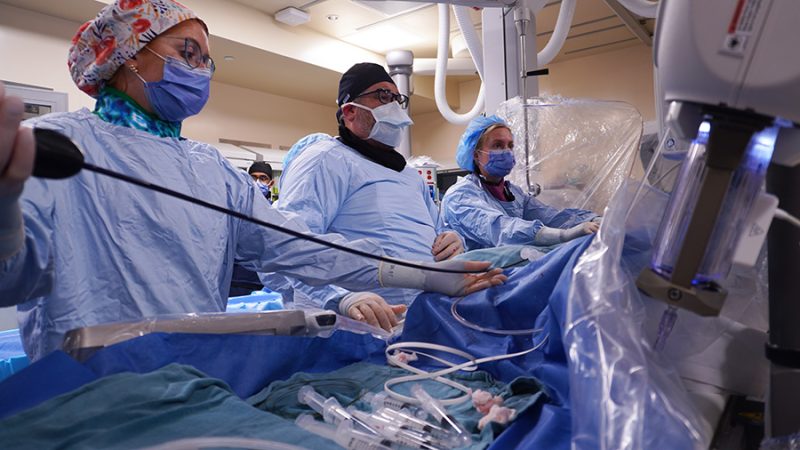UHN first hospital in Canada offering new treatment to replace diseased heart valve

UHN is the first hospital in Canada to offer a new treatment for percutaneous pulmonary heart valve replacement, providing more minimally invasive options for pulmonary valve replacement than anywhere else in the country.
North America’s first percutaneous pulmonary valve replacement was performed at the Hospital for Sick Children (SickKids) in 2006 by Dr. Eric Horlick, interventional cardiologist and Peter Munk Chair in Structural Heart Disease at UHN, and Dr. Lee Benson, interventional cardiologist at SickKids.
The first adult percutaneous pulmonary valve replacement was performed at UHN’s Peter Munk Cardiac Centre the same year.
“It was a game-changer for adult congenital heart disease (ACHD) patients,” remembers Dr. Horlick. “We were able to help these patients – most of them in their 20s and 30s – avoid open-heart surgery.”
Individuals who undergo multiple sternotomies face increased risk during and after surgery. Patients born with congenital heart disease typically undergo open-heart surgery as children and will likely need another surgical intervention in early adulthood.
Patients with Tetralogy of Fallot – a congenital heart defect which occurs when a baby’s heart forms incorrectly in utero – are almost certain to require multiple heart valve repairs or replacements in their lifetime.
Since 2006, percutaneous pulmonary valve replacements have become commonplace at specialized centres such as the Peter Munk
Cardiac Centre.
But not all ACHD patients are anatomically suitable. Up until recently, only 20 per cent of this population could undergo percutaneous pulmonary
valve replacement.
‘A remarkable achievement’
Today, Dr. Horlick and his team add another intervention to their arsenal, increasing suitability in the patient population to 80 per cent.
“Open-heart surgery in your 30s means you may not be able to work for three or four months,” says Dr. Horlick. “If you’re in your 20s, you could lose a semester or a year in school. That’s a huge deal.
“With this procedure, patients have an average stay of one day, and they leave with a fully competent valve. That’s a remarkable achievement.”
Thanks to the pioneering efforts of Dr. Horlick, Dr. Lee, and Dr. Mark Osten, Toronto General Hospital is home to the first and largest ACHD program in the world. The program provides care to nearly 10,000 patients and is a global hub for ACHD research and education.
With ACHD patients living longer than ever before, finding ways to ease disease burden and improve quality of life is at the forefront of Dr. Horlick’s mind.
“We follow these patients for life,” he says. “We see what they go through, and when we’re able to provide a solution that we didn’t have months, or even a year ago, it’s incredibly rewarding.”
Sept. 11 to 17 was Heart Valve Disease Awareness Week, an international campaign aimed at tackling what’s being called the next cardiac epidemic. More than one million Canadians are affected by heart valve disease, yet public awareness of the disease is shockingly low. Heart Valve Voice Canada and the Canadian Cardiovascular Society are joining forces to increase awareness and improve early detection by educating Canadians on heart valve disease and the importance of stethoscope checks.








